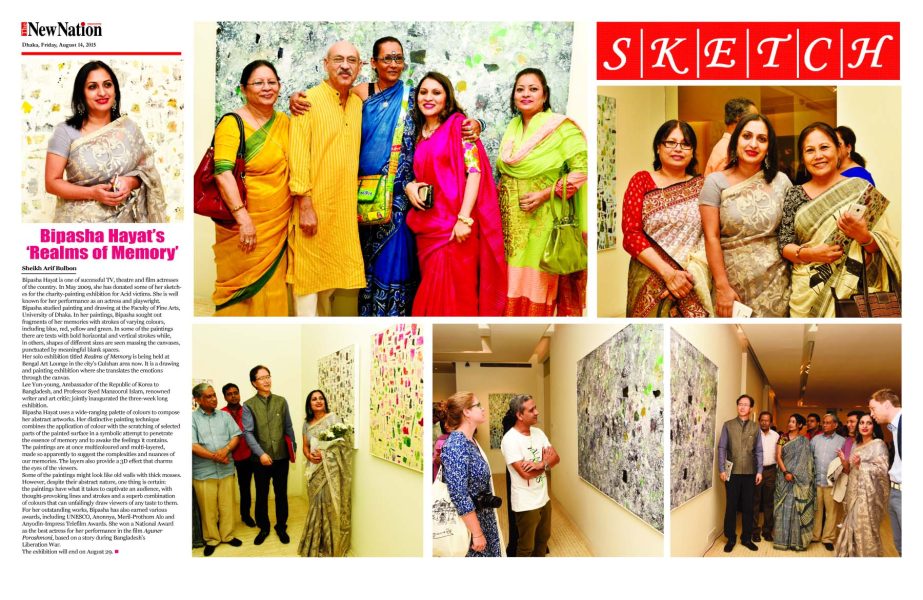
Sheikh Arif Bulbon :
Bipasha Hayat is one of successful TV, theatre and film actresses of the country. In May 2009, she has donated some of her sketches for the charity-painting exhibition for Acid victims. She is well known for her performance as an actress and playwright.
Bipasha studied painting and drawing at the Faculty of Fine Arts, University of Dhaka. In her paintings, Bipasha sought out
fragments of her memories with strokes of varying colours, including blue, red, yellow and green. In some of the paintings there are texts with bold horizontal and vertical strokes while,
in others, shapes of different sizes are seen massing the canvases, punctuated by meaningful blank spaces.
Her solo exhibition titled Realms of Memory is being held at Bengal Art Lounge in the city’s Gulshan area now. It is a drawing and painting exhibition where she translates the emotions through the canvas.
Lee Yun-young, Ambassador of the Republic of Korea to Bangladesh, and Professor Syed Manzoorul Islam, renowned writer and art critic; jointly inaugurated the three-week long
exhibition.
Bipasha Hayat uses a wide-ranging palette of colours to compose her abstract artworks. Her distinctive painting technique
combines the application of colour with the scratching of selected parts of the painted surface in a symbolic attempt to penetrate
the essence of memory and to awake the feelings it contains.
The paintings are at once multicoloured and multi-layered,
made so apparently to suggest the complexities and nuances of our memories. The layers also provide a 3D effect that charms
the eyes of the viewers.
Some of the paintings might look like old walls with thick mosses. However, despite their abstract nature, one thing is certain:
the paintings have what it takes to captivate an audience, with thought-provoking lines and strokes and a superb combination
of colours that can unfailingly draw viewers of any taste to them.
For her outstanding works, Bipasha has also earned various awards, including UNESCO, Anonnya, Meril-Prothom Alo and Anyodin-Impress Telefilm Awards. She won a National Award
as the best actress for her performance in the film Aguner Poroshmoni, based on a story during Bangladesh’s
Liberation War.
The exhibition will end on August 29. n
Bipasha Hayat is one of successful TV, theatre and film actresses of the country. In May 2009, she has donated some of her sketches for the charity-painting exhibition for Acid victims. She is well known for her performance as an actress and playwright.
Bipasha studied painting and drawing at the Faculty of Fine Arts, University of Dhaka. In her paintings, Bipasha sought out
fragments of her memories with strokes of varying colours, including blue, red, yellow and green. In some of the paintings there are texts with bold horizontal and vertical strokes while,
in others, shapes of different sizes are seen massing the canvases, punctuated by meaningful blank spaces.
Her solo exhibition titled Realms of Memory is being held at Bengal Art Lounge in the city’s Gulshan area now. It is a drawing and painting exhibition where she translates the emotions through the canvas.
Lee Yun-young, Ambassador of the Republic of Korea to Bangladesh, and Professor Syed Manzoorul Islam, renowned writer and art critic; jointly inaugurated the three-week long
exhibition.
Bipasha Hayat uses a wide-ranging palette of colours to compose her abstract artworks. Her distinctive painting technique
combines the application of colour with the scratching of selected parts of the painted surface in a symbolic attempt to penetrate
the essence of memory and to awake the feelings it contains.
The paintings are at once multicoloured and multi-layered,
made so apparently to suggest the complexities and nuances of our memories. The layers also provide a 3D effect that charms
the eyes of the viewers.
Some of the paintings might look like old walls with thick mosses. However, despite their abstract nature, one thing is certain:
the paintings have what it takes to captivate an audience, with thought-provoking lines and strokes and a superb combination
of colours that can unfailingly draw viewers of any taste to them.
For her outstanding works, Bipasha has also earned various awards, including UNESCO, Anonnya, Meril-Prothom Alo and Anyodin-Impress Telefilm Awards. She won a National Award
as the best actress for her performance in the film Aguner Poroshmoni, based on a story during Bangladesh’s
Liberation War.
The exhibition will end on August 29. n

